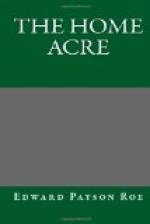Mr. A. S. Fuller is not only a well-known horticultural author, but has also had the widest experience in the culture and observation of fruit. He prefaces his opinion with the following words: “How much and how often we horticulturists have been puzzled with questions like yours! If we made no progress, were always of the same mind, and if seasons never changed, then perhaps there would be little difficulty in deciding which of the varieties of the different kinds of fruit were really the best. But seasons, our tastes, and even the varieties sometimes change; and our preferences and opinions must vary accordingly. Apples— Early Harvest, Fall Pippins, Spitzenburgh, Rhode Island Greening, Autumn Sweet Bough, and Talman’s Sweet. Cherries—Early Purple Guigne, Bigarreau of Mezel, Black Eagle, Coe’s Transparent, Governor Wood, and Belle Magnifique.”
The choice of Mr. E. S. Carmen, editor of the “Rural New Yorker:” “Apples—Early Harvest, Gravenstein, Jefferis, Baldwin, Mother, Spitzenburgh. Pears—Seckel, Tyson, Clapp’s Favorite, Bartlett, Beurre d’Anjou, and Dana’s Hovey. Cherries—Black Tartarian, Coe’s Transparent, Governor Wood, Mezel, Napoleon Bigarreau.”
The authorities appear to differ. And so they would in regard to any locality; but it should be remembered that President Wilder advises for the latitude of Massachusetts, Messrs. Fuller and Carmen for that of New Jersey. I will give now the selection of the eminent horticulturist Mr. P. O. Berckmans for the latitude of Georgia: “Cherries (this is not a good cherry-producing region, but I name the following as the best in order of merit)—Buttners, Governor Wood, Belle de Choisy, Early Richmond, and May Duke. Pears (in order of maturity)—Clapp’s Favorite, Seckel, Duchesse, Beurre Superfine, Leconte, Winter Nellis, or Glout. Morceau. Apples—Early Harvest, Red June, Carter’s Blue, Stevenson’s Winter, Shockley, Buncombe, Carolina Greening.”
He who makes his choice from these selections will not meet with much disappointment. I am aware, however, that the enjoyment of fruit depends much upon the taste of the individual; and who has a better right to gratify his taste than the man who buys, sets out, and cares for the trees? Some familiar kind not in favor with the fruit critics, an old variety that has become a dear memory of boyhood, may be the best one of all for him—perhaps for the reason that it recalls the loved faces that gathered about the wide, quaint fireplace of his childhood’s home.
It is also a well-recognized fact that certain varieties of fruit appear to be peculiarly adapted to certain localities. Because a man has made a good selection on general principles, he need not be restricted to this choice. He will soon find his trees growing lustily and making large branching heads. Each branch can be made to produce a different kind of apple or pear, and the kindred varieties of cherries will succeed on the same tree. For instance,




